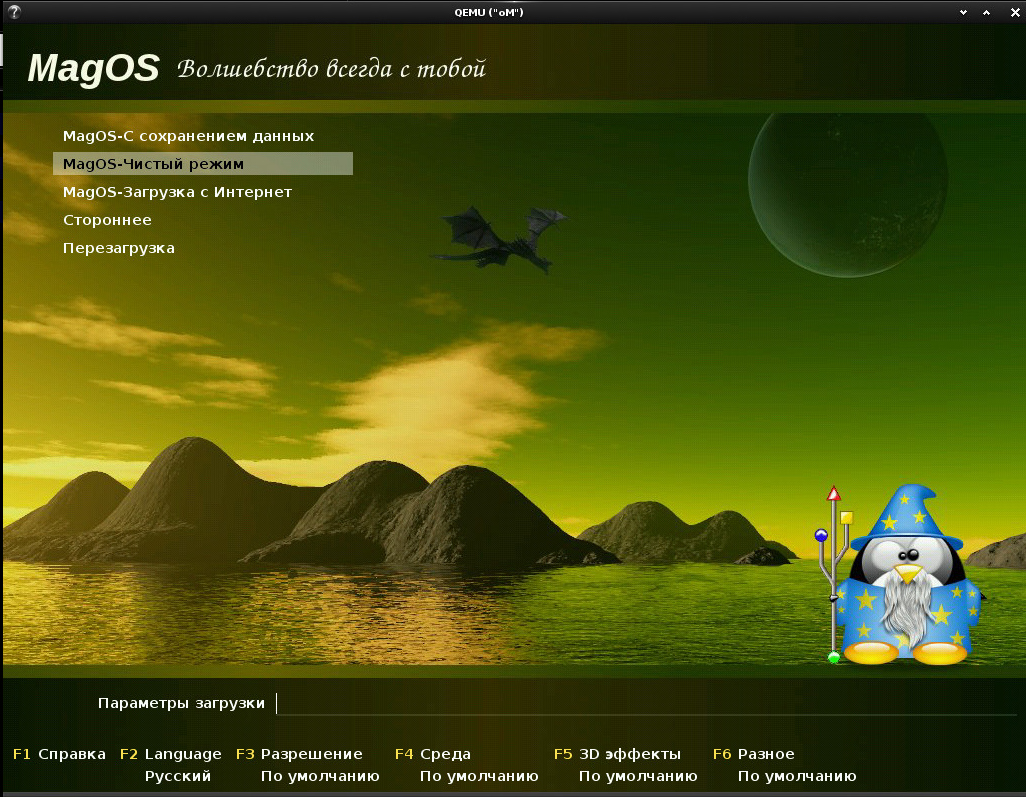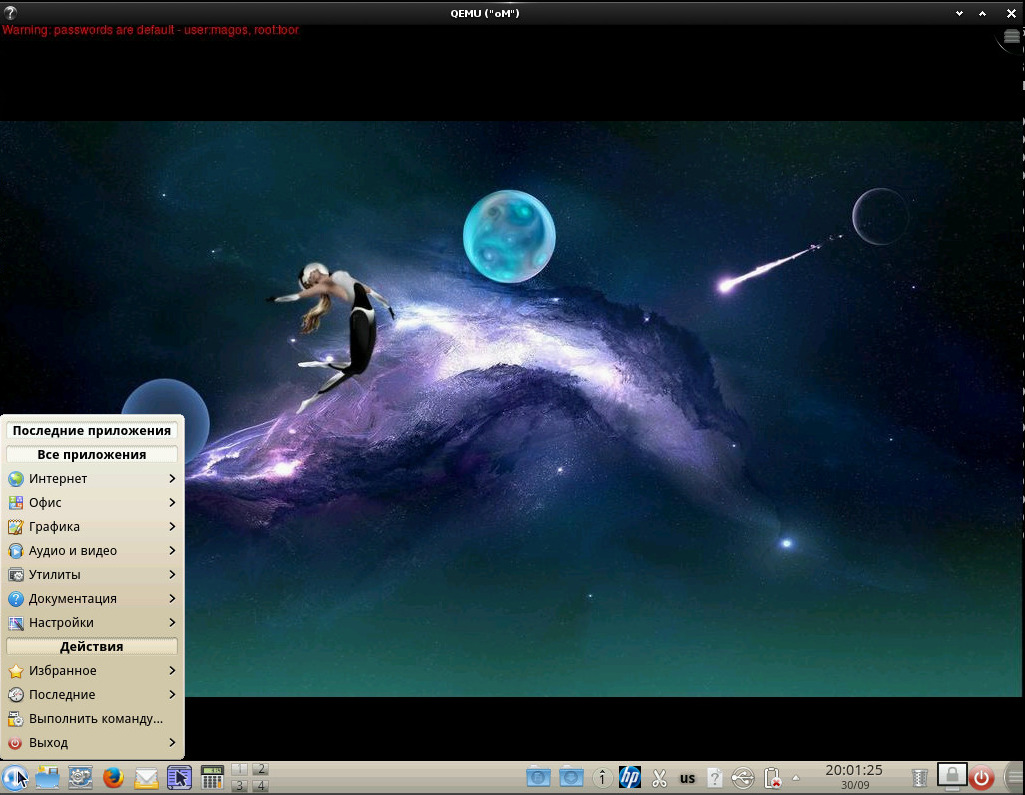MagOS Linux (September release)
Of the many Linux distributions, I wanted to find something unusual and necessarily developed by its software engineer, original.
Magos turned out to be not just a distribution in the usual sense, but a new step of living operating systems.

If you take Mandriva Linux, add the linux-live.org scripts and add the modular architecture of the slax ...
And then, of course, process a little with a file - we get magos-linux ©
MagOS differs from modularity from standard live-image distros with preservation; in squashfs it is placed not the entire distribution kit, but for each program its own mem / loop segment is allocated, into which the executable code is unpacked from the module on the fly.
')
Today there was an update.
One of the advantages of this approach is the possible acceleration of performance on the high-end cpu, if the processor processes the decompression of the .xzm module faster than simply reading from the media, all the available memory and more is naturally used.
Since the entire system is kept in memory, the fault-tolerance increases somewhat, since modules can be changed only under certain conditions, but problems appear, because if the system fails, the memory will be cleared, and the saved state will not remain on the disk, but also appear and new features. For example, you can create a whole module with all the necessary libraries.
The modules themselves are created on-the-fly when installed from the application center, or you can run the utility and it will convert the rpm package to the module, the already converted modules can be downloaded from the repository.
In fact, each module has its own “file system” system and is connected to the main aufs, like a live disk - live-cd, so the “installation” is also done by simply copying or deleting the module from the system, which makes it quite easy to build a permanent package programs.
---------------------------------------------- Screens --- ------------------------------------------- Screens ------ ---------------------------------------- Screens --------- -------------------------------------
in qemu - it is better to enable KVM, in virtualbox support for PAE.

in the boot parameters you can write
to disable compiz if there is no support for it


depending on the hardware and loadable modules, the load takes some time

this is a “non-lts” iso image of today's release, I gave 2 gigabytes and 4 cores to a virtual machine, booted up in about one and a half to two minutes, the acceleration module accelerates this time to 20 seconds.
Since the development takes a lot of time, it was decided not to deal with its distribution, but first to process another distribution, and it turned out to be easier to work with rpm, although in principle you can take any distribution - it’s a matter of people and time to finish the scripts, now it’s cloning dew, before magic, and it began with Mandrayvy. There is a repository on github, mirrors on Yandex, but one of the interesting tasks was the creation of MagNet, a distributed network for storing modules and communication between users, now the concept is undergoing some changes. along with the announced new cloud services, new opportunities for implementation have appeared.
One of the best solutions was to install the distribution in two clicks - unpack and run the script for changes in the bootloader, marking the disk areas is not needed - works with ntfs, vfat, ext3, everything works even on the current system, it is easy to install on a flash drive, although there is potential implementation is possible for more serious tasks, but it will require more efforts by developers, and testing and debugging are necessary.
Now the work is focused on accelerating the launch of the system to the DE level from 90 seconds to 20, as well as on developing a converter to modules, correcting some of the errors.
Like a real openSource project, everything here is done freely.
With the responsibility for all good and bad, as usual - GPL.
In its full form, the distribution kit is occupied by the gig link to the mirror or the link to the bt tracker, since the distribution kit rosalts (long-term-support) and fresh is now taken as the basis, then gnome is available from the available desktop files. kde. lxde. In tar.gz there are also scripts for converting to iso, so after fixing configurations and changing passwords, you can make your own disk image.
if you're interested in looking at the code or helping out, go to github.com/magos-linux , the main communication takes place on the forum .
The latest build is available on torrent tracker.
Happy Linux!
PS
Links and descriptions are also available on the wiki.
github.com/magos-linux/
Magos turned out to be not just a distribution in the usual sense, but a new step of living operating systems.

If you take Mandriva Linux, add the linux-live.org scripts and add the modular architecture of the slax ...
And then, of course, process a little with a file - we get magos-linux ©
MagOS differs from modularity from standard live-image distros with preservation; in squashfs it is placed not the entire distribution kit, but for each program its own mem / loop segment is allocated, into which the executable code is unpacked from the module on the fly.
')
Today there was an update.
One of the advantages of this approach is the possible acceleration of performance on the high-end cpu, if the processor processes the decompression of the .xzm module faster than simply reading from the media, all the available memory and more is naturally used.
Since the entire system is kept in memory, the fault-tolerance increases somewhat, since modules can be changed only under certain conditions, but problems appear, because if the system fails, the memory will be cleared, and the saved state will not remain on the disk, but also appear and new features. For example, you can create a whole module with all the necessary libraries.
Mikhail's comment (author, developer):
The modules are layered on each other, the top layer wins (if there are 2 different files with one path, it is available only from the top layer)
The modules themselves are created on-the-fly when installed from the application center, or you can run the utility and it will convert the rpm package to the module, the already converted modules can be downloaded from the repository.
In fact, each module has its own “file system” system and is connected to the main aufs, like a live disk - live-cd, so the “installation” is also done by simply copying or deleting the module from the system, which makes it quite easy to build a permanent package programs.
in qemu - it is better to enable KVM, in virtualbox support for PAE.

in the boot parameters you can write
no3ddesktop, xdriver=fbdevto disable compiz if there is no support for it


depending on the hardware and loadable modules, the load takes some time

this is a “non-lts” iso image of today's release, I gave 2 gigabytes and 4 cores to a virtual machine, booted up in about one and a half to two minutes, the acceleration module accelerates this time to 20 seconds.
Since the development takes a lot of time, it was decided not to deal with its distribution, but first to process another distribution, and it turned out to be easier to work with rpm, although in principle you can take any distribution - it’s a matter of people and time to finish the scripts, now it’s cloning dew, before magic, and it began with Mandrayvy. There is a repository on github, mirrors on Yandex, but one of the interesting tasks was the creation of MagNet, a distributed network for storing modules and communication between users, now the concept is undergoing some changes. along with the announced new cloud services, new opportunities for implementation have appeared.
One of the best solutions was to install the distribution in two clicks - unpack and run the script for changes in the bootloader, marking the disk areas is not needed - works with ntfs, vfat, ext3, everything works even on the current system, it is easy to install on a flash drive, although there is potential implementation is possible for more serious tasks, but it will require more efforts by developers, and testing and debugging are necessary.
Now the work is focused on accelerating the launch of the system to the DE level from 90 seconds to 20, as well as on developing a converter to modules, correcting some of the errors.
Michael:
About "from 90 seconds to 20" - these numbers are different on different machines
And I would not say? that we are focused on that. We do not have so many developers and everyone does what he is interested in. In this case, Anton started with this module, in the future we will have to replace the hardware definition scripts and either it will enter the assembly, like our difference from dew, or it will remain the same as in dew.
Out of opportunity?
- loading from media into memory and ejecting media
- three (four for 2012) environments at the user's choice + a rich set of applications, all this with a total weight of about 1G
- setting via ini file without modifying the distribution modules
- compiz effects slave. The tables are built in and configured for use in the KDE Gnome LXDE, they may be included from the first launch
- own modification of the grub4dos loader with support for control buttons in the graph. mode.
- network download.
- the ability to turn the system into a server with ftp smb nfs dhcpd router freenx (terminal server) pxe (download thin clients) sshd hostapd by editing a single ini file
...
my options are limited in the meantime that I have left
In fact, there remains a little more than is required to maintain the assembly in its current state; releases of assemblies occur once a month.
Development will really be when there are developers like Anton (neobht) and Alexander (betcher), ready to take on something and bring it to a working decision.
Like a real openSource project, everything here is done freely.
With the responsibility for all good and bad, as usual - GPL.
In its full form, the distribution kit is occupied by the gig link to the mirror or the link to the bt tracker, since the distribution kit rosalts (long-term-support) and fresh is now taken as the basis, then gnome is available from the available desktop files. kde. lxde. In tar.gz there are also scripts for converting to iso, so after fixing configurations and changing passwords, you can make your own disk image.
if you're interested in looking at the code or helping out, go to github.com/magos-linux , the main communication takes place on the forum .
The latest build is available on torrent tracker.
Happy Linux!
PS
Links and descriptions are also available on the wiki.
github.com/magos-linux/
Source: https://habr.com/ru/post/195710/
All Articles